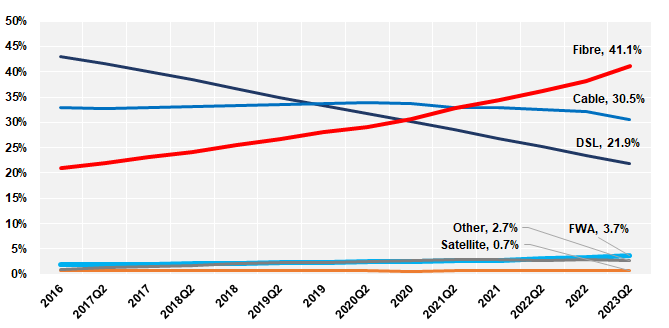Digital
OECD broadband statistics update
Paris, 12 March 2024
Fibre and Fixed Wireless Access are the two fastest growing fixed broadband technologies in the OECD
The latest OECD statistics show that Fibre and Fixed Wireless Access (FWA) have seen the strongest growth in fixed broadband technologies in three years. Fibre subscriptions have increased by 56% between June 2020 to June 2023, and FWA subscriptions have increased by 64%. The United States (252%), Estonia (153%), Norway (139%) and Spain (118%) led this FWA growth. The dynamism of fibre and FWA stands in stark contrasts to the decline in DSL (-24%).
Fibre, which is the dominant technology since 2021, amounts to 41% of total fixed broadband subscriptions in June 2023 (see graph below). FWA still represents a more modest share of 3.7% of total fixed broadband subscriptions (in countries where data is available). DSL now represents a share of 22% of total broadband, while cable accounts for 30.5% of overall connections. Satellite, which grew 11% over the last three years, represents 0.7% of fixed broadband subscribers.
Broadband access technologies as share of total fixed broadband subscriptions in OECD countries, June 2023

Nine OECD countries have more than 70% of fibre connections over total broadband, with Korea, Japan, Iceland, Spain leading the way with the highest fibre penetration rates of 89%, 86%, 85% , and 84%, respectively. The highest fibre growth rates are in Europe, with Austria and Belgium having growth rates of 75% and 73% over the last year, closely followed by Mexico with a growth in fibre of 68%. Two other Latin American countries are in the top 7: Costa Rica and Colombia with fibre growth rates of 42% and 34%, respectively.
Mobile data usage per subscription grew substantially by 28% in one year passing from 10.2 GB to 13 GB per subscription per month in OECD countries as of June 2023. The amount of data consumed in countries vary greatly from 6 GB to 46 GB, with Latvia being the OECD leader.
Despite an already very high mobile broadband penetration in the OECD area, overall mobile subscriptions continue to grow by 4.6% over the last year, which totalled 1.8 billion as of June 2023, up from 1.74 billion a year earlier. Mobile broadband penetration is highest in Japan, Estonia, the United States and Finland, with subscriptions per 100 inhabitants at 200%, 192%, 183% and 161%, respectively.
Eighteen countries were able to provide the number of their 5G subscriptions separately from mobile broadband subscriptions. The share of 5G in total mobile broadband subscriptions is 23% on average for the OECD countries that provided this data.
Machine-to-machine (M2M) SIM cards grew 14% increase in one year. The two leading countries are Sweden with 238 M2M SIM cards per 100 inhabitants and Iceland (203), followed by Austria (179), the Netherlands (93) and Norway (76). Both Sweden and Iceland issue M2M SIM cards for international use.
Download broadband data, charts and penetration maps by country at http://oe.cd/broadband.
For further information, or to discuss these trends further, journalists can contact Verena Weber (verena.weber@oecd.org), Head of the OECD’s Connectivity Services and Infrastructures (CSI) Unit by email.
Working with over 100 countries, the OECD is a global policy forum that promotes policies to preserve individual liberty and improve the economic and social well-being of people around the world
Related Documents